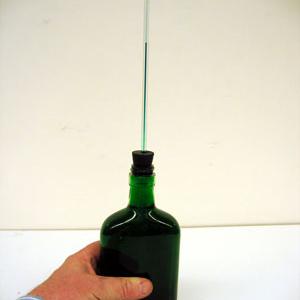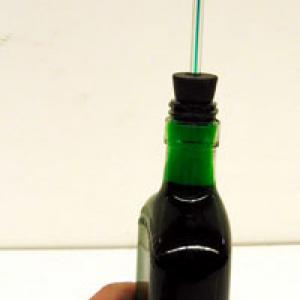College of Liberal Arts & Sciences
2B20.53 - Elasticity of Glass - Squeeze a Flask
PIRA cross reference 1R20.39
Fill the bottle with a dark liquid. Fill the flask full enough so that when inserting the capillary, several inches of liquid is forced up into the tube. Squeezing the long side of the flask should cause the liquid level in the capillary to rise. Squeezing the short side should cause the liquid level to fall.
- Salvatore J. Ronaldo and James J. D'Amario, "Elasticity of Glass", TPT, Vol. 17, # 9, Dec. 1979, p. 595.
- Julius Sumner Miller, "Another Use for a Whisky Bottle", TPT, Vol. 18, # 3, March 1980.
- M-846: "Squeezing Glass - Borax Ball", DICK and RAE Physics Demo Notebook.
Disclaimer: These demonstrations are provided only for illustrative use by persons affiliated with The University of Iowa and only under the direction of a trained instructor or physicist. The University of Iowa is not responsible for demonstrations performed by those using their own equipment or who choose to use this reference material for their own purpose. The demonstrations included here are within the public domain and can be found in materials contained in libraries, bookstores, and through electronic sources. Performing all or any portion of any of these demonstrations, with or without revisions not depicted here entails inherent risks. These risks include, without limitation, bodily injury (and possibly death), including risks to health that may be temporary or permanent and that may exacerbate a pre-existing medical condition; and property loss or damage. Anyone performing any part of these demonstrations, even with revisions, knowingly and voluntarily assumes all risks associated with them.



